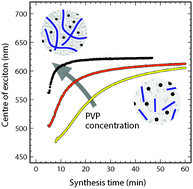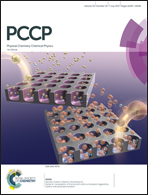Enhanced growth of tellurium nanowires under conditions of macromolecular crowding
Abstract
An unprecedented rate enhancement was observed in the wet-chemical synthesis of tellurium nanowires under crowded conditions of inert macromolecules. The synthesis was carried out at 105 °C using solutions of sodium tellurite (Na2TeO3) as a precursor, hydrazine (N2H4) as a reducing agent, and polyvinylpyrrolidone (PVP) as both a stabilizing and crowding agent. The PVP concentration was systematically varied between the dilute and crowding regimes up to 166 g l−1. The growth of the nanowires was monitored by measuring their size-dependent optical properties in the UV-Vis spectrum characterizing the size and morphology evolution of the nanowires and a coexisting phase of amorphous tellurium nanoparticles. The observed growth characteristics were interpreted in terms of non-specific structural organization of the crowded media due to the entropic-driven effects of space compartmentalization.



 Please wait while we load your content...
Please wait while we load your content...